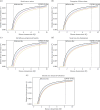A behaviour and disease transmission model: incorporating the Health Belief Model for human behaviour into a simple transmission model
- PMID: 38835247
- PMCID: PMC11338573
- DOI: 10.1098/rsif.2024.0038
A behaviour and disease transmission model: incorporating the Health Belief Model for human behaviour into a simple transmission model
Abstract
The health and economic impacts of infectious diseases such as COVID-19 affect all levels of a community from the individual to the governing bodies. However, the spread of an infectious disease is intricately linked to the behaviour of the people within a community since crowd behaviour affects individual human behaviour, while human behaviour affects infection spread, and infection spread affects human behaviour. Capturing these feedback loops of behaviour and infection is a well-known challenge in infectious disease modelling. Here, we investigate the interface of behavioural science theory and infectious disease modelling to explore behaviour and disease (BaD) transmission models. Specifically, we incorporate a visible protective behaviour into the susceptible-infectious-recovered-susceptible (SIRS) transmission model using the socio-psychological Health Belief Model to motivate behavioural uptake and abandonment. We characterize the mathematical thresholds for BaD emergence in the BaD SIRS model and the feasible steady states. We also explore, under different infectious disease scenarios, the effects of a fully protective behaviour on long-term disease prevalence in a community, and describe how BaD modelling can investigate non-pharmaceutical interventions that target-specific components of the Health Belief Model. This transdisciplinary BaD modelling approach may reduce the health and economic impacts of future epidemics.
Keywords: Health Belief Model; behaviour modelling; epidemiology; transmission modelling.
Conflict of interest statement
We declare we have no competing interests.
Figures

![The Health Belief Model [24,25], adapted from Brailsford et al. [32].](https://cdn.ncbi.nlm.nih.gov/pmc/blobs/caf2/11338573/777051a0c8aa/rsif.2024.0038.f002.gif)



Similar articles
-
Infection prevention behaviour and infectious disease modelling: a review of the literature and recommendations for the future.BMC Public Health. 2018 Mar 9;18(1):336. doi: 10.1186/s12889-018-5223-1. BMC Public Health. 2018. PMID: 29523125 Free PMC article. Review.
-
Universal screening for SARS-CoV-2 infection: a rapid review.Cochrane Database Syst Rev. 2020 Sep 15;9(9):CD013718. doi: 10.1002/14651858.CD013718. Cochrane Database Syst Rev. 2020. PMID: 33502003 Free PMC article.
-
Harnessing Social Media in the Modelling of Pandemics-Challenges and Opportunities.Bull Math Biol. 2021 Apr 9;83(5):57. doi: 10.1007/s11538-021-00895-3. Bull Math Biol. 2021. PMID: 33835296 Free PMC article.
-
Social Distance in COVID-19: Drawing the line between protective behavior and stigma manifestation.Psychiatriki. 2021 Sep 20;32(3):183-186. doi: 10.22365/jpsych.2021.025. Epub 2021 Aug 5. Psychiatriki. 2021. PMID: 34390552 English, Greek, Modern.
-
High infectiousness immediately before COVID-19 symptom onset highlights the importance of continued contact tracing.Elife. 2021 Apr 26;10:e65534. doi: 10.7554/eLife.65534. Elife. 2021. PMID: 33899740 Free PMC article.
Cited by
-
Current View on Major Natural Compounds Endowed with Antibacterial and Antiviral Effects.Antibiotics (Basel). 2024 Jun 28;13(7):603. doi: 10.3390/antibiotics13070603. Antibiotics (Basel). 2024. PMID: 39061285 Free PMC article. Review.
-
Face mask mandates alter major determinants of adherence to protective health behaviours in Australia.R Soc Open Sci. 2025 Mar 26;12(3):241941. doi: 10.1098/rsos.241941. eCollection 2025 Mar. R Soc Open Sci. 2025. PMID: 40144292 Free PMC article.
-
Association of COVID-19 outcomes with measures of institutional and interpersonal trust: an ecological analysis using national data from 61 countries.Sci Rep. 2025 Jul 21;15(1):26393. doi: 10.1038/s41598-025-09758-6. Sci Rep. 2025. PMID: 40691221 Free PMC article.
References
-
- Aouissi HA, Kechebar MSA, Ababsa M, Roufayel R, Neji B, Petrisor AI, Hamimes A, Epelboin L, Ohmagari N. 2022. The importance of behavioral and native factors on COVID-19 infection and severity: insights from a preliminary cross-sectional study. Healthcare 10 , 1341. (10.3390/healthcare10071341) - DOI - PMC - PubMed
MeSH terms
Grants and funding
LinkOut - more resources
Full Text Sources
Medical
Research Materials

